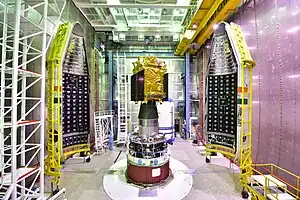 Aditya-L1 in preflight | |
| Mission type | Solar observation |
|---|---|
| Operator | ISRO |
| COSPAR ID | 2023-132A |
| SATCAT no. | 57754 |
| Website | www |
| Mission duration | 5.2 years (planned)[1] 4 months and 15 days (elapsed) |
| Spacecraft properties | |
| Spacecraft | PSLV-XL/C-57 |
| Spacecraft type | PSLV |
| Bus | I-1K[2] |
| Manufacturer | ISRO / IUCAA / IIA |
| Launch mass | 1,475 kg (3,252 lb)[3] |
| Payload mass | 244 kg (538 lb)[1] |
| Start of mission | |
| Launch date | 2 September 2023, 11:50 IST (06:20 UTC)[4][5] |
| Rocket | PSLV-XL C57 |
| Launch site | Satish Dhawan Space Centre |
| Contractor | ISRO |
| Orbital parameters | |
| Reference system | Sun–Earth L1 orbit |
| Regime | Halo orbit |
| Period | 177.86 days[6] |
| Epoch | 6 January 2024[7] |
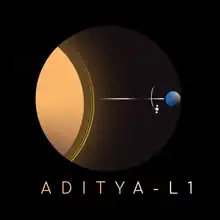 Mission Insignia | |
Aditya-L1 (/aːd̪it̪jə/)[lower-alpha 1] (from Sanskrit: Aditya, "Sun" and L1, "Lagrange point 1") is a coronagraphy spacecraft for studying the solar atmosphere, designed and developed by the Indian Space Research Organisation (ISRO) and various other Indian Space Research Institutes.[1] It is orbiting at about 1.5 million km from Earth in a halo orbit around the Lagrange point 1 (L1) between the Earth and the Sun, where it will study the solar atmosphere, solar magnetic storms, and their impact on the environment around the Earth.[8]
It is the first Indian mission dedicated to observe the Sun. Nigar Shaji is the project's director.[9][10][11][12] Aditya-L1 was launched aboard the PSLV C57 at 11:50 IST on 2 September 2023,[13][4][5] It successfully achieved its intended orbit nearly an hour later, and separated from its fourth stage at 12:57 IST.[14] It was inserted at the L1 point on 6 January 2024, at 4:17 pm IST.[15]
Mission objectives
The main objectives of Aditya-L1 are:
- To observe the dynamics of the Sun's chromosphere and corona:
- To study chromospheric and coronal heating, the physics of partially ionised plasma, of coronal mass ejections (CMEs) and their origins, of the coronal magnetic field and heat transfer mechanisms, and flare exchanges.
- To observe the physical particle environment around its position.
- To determine the sequence of processes in multiple layers below the corona that lead to solar eruptions.
- To study space weather, and the origin, composition and dynamics of solar wind.[16]
History
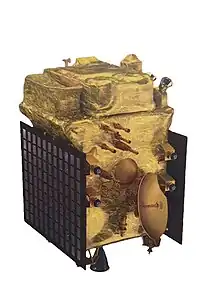
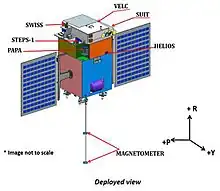
The mission was conceptualised in January 2008 by the Advisory Committee for Space Sciences (ADCOS).[17][18] It was initially envisaged as a small, 400 kg (880 lb) satellite in a Low Earth Orbit (800 km) with a coronagraph to study the solar corona. An experimental budget of ₹3 crore was allocated for the financial year 2016–2017.[19][20][21] The scope of the mission has since been expanded and it became a comprehensive solar and space environment observatory to be placed at Lagrange point 1 (L1),[22] hence the mission was renamed as "Aditya-L1". As of July 2019, the mission has an allocated cost of ₹378 crores, excluding launch costs.[5]
The European Space Operations Centre (ESOC), operated by the European Space Agency (ESA) is supporting the mission.[23]
Overview
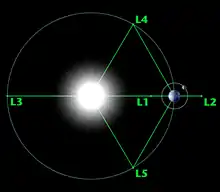
The mission took 126 Earth days after launch to reach the halo orbit around the L1 point, which is about 1,500,000 km (930,000 mi) from Earth.[24] The spacecraft is planned to remain in the halo orbit for its mission duration while being maintained at a stationkeeping Δv of 0.2–4 m/s per year.[25] The 1,500 kg (3,300 lb) satellite carries seven science payloads with various objectives, including instruments to measure coronal heating, solar wind acceleration, coronal magnetometry, origin and monitoring of near-UV solar radiation (which drives Earth's upper atmospheric dynamics and global climate), coupling of the solar photosphere to the chromosphere and corona,[26] and in-situ characterisations of the space environment around Earth by measuring energetic particle fluxes and magnetic fields of the solar wind, and solar magnetic storms.[1]
Aditya-L1 will provide observations of the Sun's photosphere, chromosphere and corona. Its scientific payloads must be placed outside the interference from the Earth's magnetic field, and hence, could not have been useful in the low Earth orbit, as proposed in the original mission concept back in 2008.[27]
One of the major unsolved problems in the field of solar physics is coronal heating. The upper atmosphere of the Sun has a temperature of 2,000,000 K (2,000,000 °C; 3,600,000 °F), whereas the lower atmosphere is just 6,000 K (5,730 °C; 10,340 °F).[28] In addition, it is not understood exactly how the Sun's radiation affects the dynamics of the Earth's atmosphere on a shorter as well as a longer time scale. The mission will obtain near-simultaneous images of the different layers of the Sun's atmosphere, which will reveal the ways in which energy is channeled and transferred from one layer to another. Thus, the mission will enable a comprehensive understanding of the dynamical processes of the Sun and address some of the outstanding problems in solar physics and heliophysics.
Payloads

The instruments of Aditya-L1 are tuned to observe the solar atmosphere, mainly the chromosphere and corona. In-situ instruments will observe the local environment at the L1 point. There are seven payloads onboard, with four for remote sensing of the Sun and three for in-situ observation. The payloads have been developed by different laboratories in the country with close collaborations of various ISRO centres.[29]
| Type | Sl.No | Payload | Capability | Laboratories |
|---|---|---|---|---|
| Remote Sensing Payloads | 1 | Visible Emission Line Coronagraph (VELC) | Corona Imaging and spectroscopy | Indian Institute of Astrophysics, Bangalore |
| 2 | Solar Ultraviolet Imaging Telescope (SUIT) | Photosphere and chromosphere imaging-narrow and broadband | Inter University Centre for Astronomy & Astrophysics, Pune | |
| 3 | Solar Low Energy X-ray Spectrometer (SoLEXS) | Soft X-ray spectrometer: Sun-as-a-star observation | U R Rao Satellite Centre, Bangalore | |
| 4 | High Energy L1 Orbiting X-ray Spectrometer (HEL1OS) | Hard X-ray spectrometer: Sun-as-a-star observation | ||
| In-situ Payloads | 5 | Aditya Solar wind Particle Experiment (ASPEX) | Solar wind and Particle analyzer: Protons and Heavier ions with directions | Physical Research Laboratory, Ahmedabad |
| 6 | Plasma Analyser Package For Aditya (PAPA) | Solar wind and Particle Analyzer: Electrons and Heavier Ions with directions | Space Physics Laboratory, Vikram Sarabhai Space Centre, Thiruvananthapuram | |
| 7 | Advanced Tri-axial High Resolution Digital Magnetometers | In-situ magnetic field (Bx, By and Bz). | Laboratory for Electro Optics Systems, Bangalore |
Visible Emission Line Coronagraph (VELC)
The Visible Emission Line Coronagraph (VELC) is a key instrument on the Aditya spacecraft. The VELC is an internally occulted reflective coronagraph designed to fulfil specific observation needs. The instrument allows for high spatial resolution imaging 1.25-2.5 arcseconds of the Sun's corona, simultaneous observations in three modes (Imaging, Spectroscopy and Spectro-polarimetry), and even utilizes artificial intelligence to aid in the detection of coronal mass ejections (CMEs). The instrument was developed by Indian Institute of Astrophysics, Bangalore.[30]
Solar Ultraviolet Imaging Telescope (SUIT)
The SUIT is an ultraviolet imaging telescope designed to study the solar spectral radiation in the ultraviolet range, using narrowband and broadband spectral filters in the range of 200-400 nm with the hope of developing a better understanding between solar activity and the atmospheric dynamics of Earth. The SUIT provides near-simultaneous coverage of the solar atmosphere, from lower photosphere to the upper chromosphere. The instrument was developed by Inter University Centre for Astronomy & Astrophysics, Pune, in collaboration with ISRO.[30]
Solar Low Energy X-ray Spectrometer (SoLEXS)
The SoLEXS is an X-ray spectrometer designed to continuously measure the solar soft X-ray flux (1 keV-22 keV) from the Sun-Earth Lagrangian point L1. These measurements can be used to better understand the properties of the Sun's corona, in particular, why the temperature of the corona is so high. The SoLEXS will observe solar flares, and in conjunction with data provided by the VELC, will help study the complex thermal properties of the Sun's outer layers. The instrument was developed by U R Rao Satellite Centre, Bangalore.[30]
High Energy L-1 Orbiting X-ray Spectrometer (HEL1OS)
Developed by the Space Astronomy Group, URSC, the HEL1OS (pronounced helios) is an x-ray spectrometer designed to study solar flares in the x-ray spectrum, in particular, energy bands of 10-150 Kev (kilo-electron volts). Using a twin-pair of Cadmium Telluride (CdTe) and Cadmium Zinc Telluride (CZT) detectors, the instrument aims to study the acceleration and movement of electrons in the Sun's corona, as well as to study the cut-off energy between thermal and non-thermal solar emissions.[30]
Aditya Solar Wind Particle Experiment (ASPEX)
The ASPEX is an instrument composed of low and high energy particle spectrometers, designed to conduct measurements of the Sun's solar wind particles. Solar Wind Ion Spectrometer (SWIS), the low energy spectrometer, contains two analysers, each designed to study particles entering the device in different planes. Supra Thermal Energetic Particle Spectrometer (STEPS), the high energy spectrometer, also consists of two parts, STEPS 1 and STEPS 2, both designed to separate protons and alpha particles and measure the integrated flux. The instrument was developed by Physical Research Laboratory, Ahmedabad.[30]
Plasma Analyser Package for Aditya (PAPA)
The PAPA is an instrument onboard the Aditya-L1 designed to study the temperature, distribution and velocity of the solar winds. The instrument contains two sensors; the Solar Wind Electron Energy Probe (SWEEP) and the Solar Wind lon Composition Analyser (SWICAR). The detectors are used in conjunction to analyse the energy levels of electrons and ions within the solar wind. The instrument was developed by the Space Physics Laboratory of the Vikram Sarabhai Space Centre, Thiruvananthapuram.[30]
Digital Magnetometers
Onboard the Aditya-L1 spacecraft are a pair of magnetic sensors on a deployable boom, one positioned in the middle and the other at the tip. The purpose of these sensors is to gather information about the magnitude and direction of the Interplanetary Magnetic Fields (IMF), as well as to study other events such as Coronal Mass Ejections (CME). Data from the magnetic sensors will be used to supplement that of the PAPA and ASPEX sensors.[30]
Mission profile
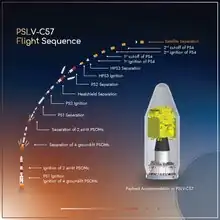
Launch
_to_Second_Launch_Pad_(SLP)_05.webp.png.webp)
On 2 September 2023, at 11:50 IST, the Polar Satellite Launch Vehicle (PSLV-C57) accomplished a successful launch of the Aditya-L1 from the Second Launch Pad of the Satish Dhawan Space Centre (SDSC) located in Sriharikota.
Aditya-L1, following a flight duration of 63 minutes and 20 seconds, achieved a successful injection into an elliptical orbit around the Earth at 12:54 IST.[31]
Aditya-L1 is scheduled to undergo a series of four Earth-bound orbital maneuvres prior to its injection to a transfer orbit towards the Lagrange point (L1). It reached its designated orbit at the L1 point 126 days after its launch on 6 January 2024 at 4:17 IST.[32][33]
Orbit raising burns
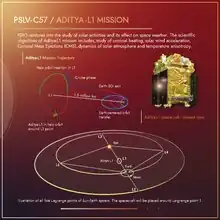
- First orbit raising burn
On 3 September 2023, the Aditya-L1 performed its first Earth-bound maneuvre, raising its orbit to a 245 km (152 mi) into 22,459 km (13,955 mi) orbit.[34]
- Second orbit raising burn
On 5 September 2023, Aditya-L1 performed its second Earth-bound maneuvre, raising its orbit to a 282 km (175 mi) into 40,225 km (24,995 mi) orbit.
- Third orbit raising burn
On 10 September 2023, Aditya-L1 performed its third Earth-bound maneuvre, raising its orbit to a 296 km (184 mi) into 71,767 km (44,594 mi) orbit.
- Fourth orbit raising burn
On 15 September 2023, Aditya-L1 performed its fourth Earth-bound maneuvre, raising its original orbit to a 256 km (159 mi) into 121,973 km (75,791 mi) orbit. This is the last of such maneuvres, being directly followed by the Trans-Lagrangian 1 Injection, bound to take place on 19 September.
- Trans-Lagrangian 1 Injection
On 19 September 2023, Aditya-L1 performed its last maneuvre around Earth to escape its orbit and headed towards the Lagrange 1 point. It will take at least four months to further reach its destination, 1.5 million kilometers away.[35]
On 30 September 2023, Aditya-L1 had escaped the Earth’s sphere of influence and was on the way to the Lagrange point 1.[35]
- Trajectory correction maneuver
On 6 October 2023, Aditya-L1 performed a Trajectory Correction maneuvre (TCM1). It was needed to correct the trajectory evaluated after tracking the Trans-Lagrangian Point 1 Insertion (TL1I) maneuvre performed on 19 September 2023.[36]
- Halo orbit insertion
On 6 January 2024, Aditya-L1 was successfully injected on the Halo orbit of Lagrange point 1 (HOI), at 4:17 pm IST.[37]
| Stage and Sequence | Date/Time | Time (IST) | Periapsis | Apoapsis | Orbital Period | Burn TIme | Ref. |
|---|---|---|---|---|---|---|---|
| Launch | |||||||
| Earth Orbit Insertion | 2 September 2023 | 12:54 p.m | 235 km (146 mi) | 19,500 km (12,100 mi) | 22 hours, 46 minutes | [38] | |
| Earth Bound maneuvres | |||||||
| Earth Bound maneuvre 1 | 3 September 2023 | 11:40 a.m. | 245 km (152 mi) | 22,459 km (13,955 mi) | 39 hours, 20 minutes | [39] | |
| Earth Bound maneuvre 2 | 5 September 2023 | 3:00 a.m | 282 km (175 mi) | 40,225 km (24,995 mi) | 4 days, 23 hours and 30 minutes | [40] | |
| Earth Bound maneuvre 3 | 10 September 2023 | 2:30 am | 296 km (184 mi) | 71,767 km (44,594 mi) | 4 days, 23 hours and 45 minutes | [41] | |
| Earth Bound maneuvre 4 | 15 September 2023 | 2:15 am | 256 km (159 mi) | 121,973 km (75,791 mi) | 3 days, 23 hours and 45 minutes | [42] | |
| Trans-Lagrangian Point 1 Injection | 19 September 2023 | 2:00 am | [43] | ||||
| Trajectory correction maneuvres | |||||||
| Trajectory Correction maneuvre (TCM) | 6 October 2023 | 16s | [44] | ||||
| Halo orbit injection | |||||||
| Halo orbit insertion (HOI) | 6 January 2024 | 4:17 pm | approx. 177.86 earth days | [45] | |||
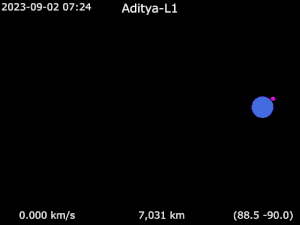

Team
- Nigar Shaji - Project director
- Sankarasubramanian K - Principal scientist of the mission[46]
See also
- Lagrange point – Equilibrium points near two orbiting bodies
- Solar space missions
- Advanced Composition Explorer – NASA satellite of the Explorer program, at SE-L1, studying solar wind etc
- Solar Dynamics Observatory – NASA mission, launched in 2010 to SE-L1
- Solar and Heliospheric Observatory – European space observatory
- Solar Orbiter – European space-based solar observatory
- Parker Solar Probe – NASA robotic space probe of the outer corona of the Sun
- ISRO – India's national space agency
References
- ↑ from Sanskrit Āditya, a synonym for the Hindu solar deity, Surya.
- 1 2 3 4 Somasundaram, Seetha; Megala, S. (25 August 2017). "Aditya-L1 mission" (PDF). Current Science. 113 (4): 610. Bibcode:2017CSci..113..610S. doi:10.18520/cs/v113/i04/610-612. Archived from the original (PDF) on 25 August 2017. Retrieved 25 August 2017.
- ↑ Nowakowski, Tomas (4 February 2016). "India's first solar mission to be launched in 2019–20". Space Flight Insider. Archived from the original on 3 September 2023. Retrieved 3 September 2023.
- ↑ International Space Conference and Exhibition – DAY 3 (video). Confederation of Indian Industry. 15 September 2021. Event occurs at 2:07:36–2:08:38. Retrieved 18 September 2021 – via YouTube.
- 1 2 "Moon mission done, ISRO aims for the Sun with Aditya-L1 launch on September 2". The Indian Express. 28 August 2023. Archived from the original on 28 August 2023. Retrieved 28 August 2023.
- 1 2 3 Pandey, Geeta (2 September 2023). "Aditya-L1: India launches its first mission to Sun". BBC News. Archived from the original on 2 September 2023. Retrieved 2 September 2023.
- ↑ Sreekumar, P. (19 June 2019). "Indian Space Science & Exploration : Global Perspective" (PDF). UNOOSA. p. 8. Archived (PDF) from the original on 30 June 2019. Retrieved 30 June 2019.
- ↑ Gupta, Shobhit (6 January 2024). "Aditya L1 LIVE: ISRO's first Sun mission successfully injected into final orbit". Hindustan Times. Retrieved 6 January 2024.
- ↑ "Aditya – L1 First Indian mission to study the Sun". ISRO. Archived from the original on 3 March 2018. Retrieved 1 June 2017.
- ↑ "Meet The Project Director Of Ambitious Mission Aditya-L1 | Nigar Shaji from Tamil Nadu". TimesNow. 2 September 2023. Archived from the original on 2 September 2023. Retrieved 2 September 2023.
- ↑ "ISROs Aditya-L1 Solar Mission: Nigar Shaji Addresses After Successful Launch Of First Sun Mission". Zee News. Archived from the original on 2 September 2023. Retrieved 2 September 2023.
- ↑ "Meet Nigar Shaji from TN's Tenkasi, Aditya-L1 mission project director". The New Indian Express. Archived from the original on 2 September 2023. Retrieved 2 September 2023.
- ↑ "Meet Nigar Shaji, The Project Director Of India's First Sun Mission: 5 Points". NDTV.com. Archived from the original on 2 September 2023. Retrieved 2 September 2023.
- ↑ ISRO [@isro] (1 September 2023). "PSLV-C57/Aditya-L1 Mission: The 23-hour 40-minute countdown leading to the launch at 11:50 Hrs. IST on September 2, 2023, has commended today at 12:10 Hrs. The launch can be watched LIVE on ISRO Website https://isro.gov.in Facebook https://facebook.com/ISRO YouTube https://youtube.com/watch?v=_IcgGYZTXQw… DD National TV channel from 11:20 Hrs. IST" (Tweet) – via Twitter.
- ↑ "Aditya L1 Mission: Aditya L1 Launch LIVE Updates: Aditya L1 spacecraft successfully separated from PSLV rocket, now en route to Sun-Earth L1 point. ISRO says mission accomplished". The Economic Times. 2 September 2023. Archived from the original on 3 September 2023. Retrieved 2 September 2023.
- ↑ "Aditya-L1 Mission Live Updates: Isro successfully injects Aditya-L1, designed to study Sun, in halo orbit". The Times of India. 6 January 2024. Retrieved 6 January 2024.
- ↑ "ADITYA-L1". www.isro.gov.in. Archived from the original on 3 August 2023. Retrieved 29 August 2023.
- ↑ "SAC Industry Portal". www.sac.gov.in. Space Applications Center, Government of India. Archived from the original on 3 August 2022. Retrieved 3 September 2023.
- ↑ Teotia, Riya, ed. (14 August 2023). "ISRO shares first images of Aditya-L1 satellite ahead of India's first-ever mission to study the Sun". WION. Archived from the original on 3 September 2023. Retrieved 3 September 2023.
- ↑ "Notes on Demands for Grants, 2016–2017" (PDF) (Press release). Department of Space. Archived from the original (PDF) on 17 September 2016. Retrieved 9 September 2016.
- ↑ "Aditya gets ready to gaze at the sun". The Hindu. Archived from the original on 26 August 2017. Retrieved 25 August 2017.
- ↑ Gandhi, Divya (13 January 2008). "ISRO planning to launch satellite to study the sun". The Hindu. Archived from the original on 15 September 2018. Retrieved 26 August 2017.
- ↑ Desikan, Shubashree (15 November 2015). "The sun shines on India's Aditya". The Hindu. Archived from the original on 13 March 2018. Retrieved 12 August 2018.
- ↑ "ISRO delegation visits ESA mission control". European Space Agency. 11 January 2024. Retrieved 14 January 2024.
- ↑ "Department Of Space, Annual Report 2019–2020" (PDF). 14 February 2020. Archived (PDF) from the original on 7 October 2021. Retrieved 25 October 2021.
- ↑ Muralidharan, Vivek (2017). "Orbit Maintenance Strategies for Sun-Earth/Moon Libration Point Missions: Parameter Selection for Target Point and Cauchy-Green Tensor Approaches". Open Access Theses. West Lafayette, Indiana, United States: M.S. Thesis, Purdue University: 183–194. Archived from the original on 31 August 2023. Retrieved 31 August 2023.
- ↑ Wedemeyer-Böhm, S.; Lagg, A.; Nordlund, Å (15 September 2009). "Coupling from the photosphere to the chromosphere and the corona". Space Science Reviews. 144 (1–4): 317–350. arXiv:0809.0987. doi:10.1007/s11214-008-9447-8. ISSN 0038-6308.
- ↑ "Aditya-L1 First Indian mission to study the Sun". isro.gov.in. Archived from the original on 10 December 2019. Retrieved 19 June 2019.
- ↑ "Temperatures Across Our Solar System - NASA Science". science.nasa.gov. Retrieved 30 November 2023.
- ↑ "ISRO ADITYA-L1". Archived from the original on 3 August 2023. Retrieved 15 July 2023.
- 1 2 3 4 5 6 7 "ADITYA-L1". www.isro.gov.in. Retrieved 25 October 2023.
- ↑ "PSLV-C57 / ADITYA-L1 Mission - Press Release". www.isro.gov.in. Archived from the original on 3 September 2023. Retrieved 3 September 2023.
- ↑ "PSLV-C57/ADITYA-L1 Mission". www.isro.gov.in. Archived from the original on 3 September 2023. Retrieved 2 September 2023.
- ↑ "Aditya L1 Mission LIVE Updates: India creates yet another landmark, country's first solar observatory Aditya-L1 reaches its destination, says PM Modi". Moneycontrol. 6 January 2024. Retrieved 6 January 2024.
- ↑ @isro (3 September 2023). "Aditya L1" (Tweet). Retrieved 3 September 2023 – via Twitter.
- 1 2 "ADITYA-L1 Mission Details". www.isro.gov.in. Retrieved 25 October 2023.
- ↑ "ADITYA-L1". www.isro.gov.in. Retrieved 30 September 2023.
- ↑ "Aditya-L1, ISRO's first solar spacecraft enters Sun's final orbit". The Economic Times. 6 January 2024. Retrieved 6 January 2024.
- ↑ ISRO [@isro] (2 September 2023). "The launch of Aditya-L1 by PSLV-C57 is accomplished successfully. The vehicle has placed the satellite precisely into its intended orbit. India's first solar observatory has begun its journey to the destination of Sun-Earth L1 point" (Tweet) – via Twitter.
- ↑ ISRO [@isro] (3 September 2023). "The satellite is healthy and operating nominally. The first Earth-bound maneuvre (EBN#1) is performed successfully from ISTRAC, Bengaluru. The new orbit attained is 245km x 22459 km. The next maneuvre (EBN#2) is scheduled for September 5, 2023, around 03:00 Hrs. IST" (Tweet) – via Twitter.
- ↑ ISRO [@isro] (4 September 2023). "Aditya-L1 Mission: The second Earth-bound maneuvre (EBN#2) is performed successfully from ISTRAC, Bengaluru. ISTRAC/ISRO's ground stations at Mauritius, Bengaluru and Port Blair tracked the satellite during this operation. The new orbit attained is 282 km x 40225 km. The next maneuvre (EBN#3) is scheduled for September 10, 2023, around 02:30 Hrs. IST" (Tweet) – via Twitter.
- ↑ ISRO [@isro] (9 September 2023). "Aditya-L1 Mission:The third Earth-bound maneuvre (EBN#3) is performed successfully from ISTRAC, Bengaluru.ISRO's ground stations at Mauritius, Bengaluru, SDSC-SHAR and Port Blair tracked the satellite during this operation.The new orbit attained is 296 km x 71767 km. The next maneuvre (EBN#4) is scheduled for September 15, 2023, around 02:00 Hrs. IST" (Tweet) – via Twitter.
- ↑ ISRO [@isro] (14 September 2023). "Aditya-L1 Mission: The fourth Earth-bound maneuvre (EBN#4) is performed successfully. ISRO's ground stations at Mauritius, Bengaluru, SDSC-SHAR and Port Blair tracked the satellite during this operation, while a transportable terminal currently stationed in the Fiji islands for Aditya-L1 will support post-burn operations. The new orbit attained is 256 km x 121973 km. The next maneuvre Trans-Lagragean Point 1 Insertion (TL1I) a send-off from the Earth is scheduled for September 19, 2023, around 02:00 Hrs.IST" (Tweet) – via Twitter.
- ↑ ISRO [@isro] (18 September 2023). "Aditya-L1 Mission: Off to Sun-Earth L1 point! The Trans-Lagrangean Point 1 Insertion (TL1I) maneuvre is performed successfully. The spacecraft is now on a trajectory that will take it to the Sun-Earth L1 point. It will be injected into an orbit around L1 through a maneuver after about 110 days. This is the fifth consecutive time ISRO has successfully transferred an object on a trajectory toward another celestial body or location in space" (Tweet) – via Twitter.
- ↑ "ADITYA-L1". www.isro.gov.in. Retrieved 8 October 2023.
- ↑ "Halo-Orbit Insertion of Aditya-L1 Successfully Accomplished". ISRO. 6 January 2024. Retrieved 6 January 2024.
- ↑ "Educational qualification of scientists behind ISRO's solar mission, Aditya L-1". DNA India. Archived from the original on 4 September 2023. Retrieved 4 September 2023.



